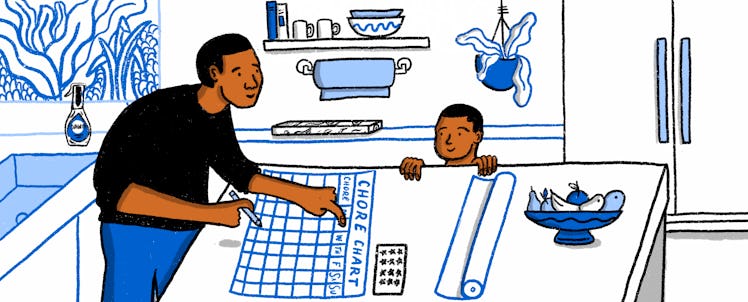It’s Time to Get a Chore Chart (For Dad)
Want to make sure you're doing your fair share of the housework? Use a chore chart.

This story was produced in partnership with Dawn and Swiffer.
A chore chart is a time-tested parenting tool, an easy way to remind kids what they need to do, when they need to do it, and whether they’ve done it or not. It’s a simple table that contains chores (listed vertically) and days of the week (listed horizontally), with the boxes at the intersection of each row and column used to record when a chore is complete, making it plain to them (and you) which tasks are not yet done.
Fundamentally, chore charts are accountability tools. And while they’re typically reserved to ensure kids make their bed, brush their teeth, and change the dog’s water bowl, children aren’t the only members of the family who should be using one.
While men are certainly making strides in household equity, the so-called chore gap is very real. And there is considerable evidence that shows how women still bear the burden of household labor. A recent survey of 1,578 American adults conducted by Dawn and Swiffer adds more evidence. It found that women spend an average of 100 more hours a year doing housework than men and that 63 percent of women say they take on the main responsibility of household chores. The good news is that the survey also found that, during the pandemic, people who noticed and worked to improve the division in household chores reported stronger family relationships, more time together as a family, and more time together romantically as spouses.
But in order to enjoy these benefits in your household, two things need to happen. First, partners need to sit down and have a frank discussion about the current divide of domestic labor in your family. Hash it out. Get specific about each and every task. If you find that one person is doing more than their fair share of the household labor, then you should discuss what a fair balance would look like. Once you’ve settled on something you both think is more balanced, have a conversation with the whole family and explain to your kids why things are changing and what they will be expected to do under the new system.
Once everyone is on the same page, the next step is to make sure it actually happens. And accountability tools like chore charts are particularly helpful when there’s a new system to implement.
As it is a visual representation of what needs to be done and by whom, a chore chart eliminates assumptions and guesswork. For busy families, in particular, it’s a simple method of giving everyone control and accountability. There’s less confusion and, as a result, fewer arguments that begin with “oh, I thought you were going to do that.” What’s more, when a child sees that dad is abiding by his personal chore chart, it makes them more likely to follow their own. This is also the kind of modeling that prevents the old “do as I say, not as I do” line of argument, which every parent knows is an argument of last resort.
But the biggest reason dads should try a chore chart is to ensure that they make progress in closing the chore gap in their own home. While there might be an agreement in the moment on what should be done, a visual reminder that’s just always there is a great way to make sure that it actually happens — and that your family reaps the benefits of a more equitable allotment of chores.
So, give it a try. To make things even easier for you, we’ve created a template for dads looking to utilize their own chore chart. It’s blank and can be used on all manner of chores. Used properly and consistently, it’s a great way to gain more time together as a family while ensuring that no one member shoulders a disproportionate share of the household burden.
This article was originally published on